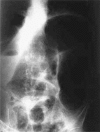Ileosigmoid knotting
Abstract
Ileosigmoid knotting (ISK) is the wrapping of the ileum around the sigmoid colon and its mesentery or vice-versa. The incidence of ISK is not well known, but it generally occurs in areas with a high incidence of sigmoid volvulus, and it is common in adult males. The etiology of ISK is controversial. The main symptoms are abdominal pain, distention, obstipation, and vomiting, while the main signs are abdominal distention and tenderness. There are no specific blood tests for diagnosing ISK. Plain abdominal X-ray radiographs demonstrate a dilated sigmoid colon and multiple small intestinal air-fluid levels. Abdominal CT demonstrates a twisted and dilated sigmoid colon with whirled sigmoid mesentery, in addition to twisted and dilated small intestinal segments. The accurate preoperative diagnosis of ISK is difficult. After rapid and prompt resuscitation, emergency surgery is needed in the treatment of ISK. In gangrenous cases, resection with primary anastomosis is preferred, while, in nongangrenous cases, untying of the knot may be performed as a sole surgical procedure, or a volvulus-preventing procedure may be added. The mean mortality rate for ISK is 6.8-8% in nongangrenous and 20-100% in gangrenous cases.
İleosigmoid düğümlenme (İSD), ileum veya sigmoid kolonun diğeri ve onun mezosu etrafında dönmesidir. İSD’nin görülme sıklığı çok iyi bilinmez, fakat genel olarak sigmoid volvulusun yüksek oranda görüldüğü yerlerde görülür ve erişkin erkeklerde daha sıktır. İSD’nin etiyolojisi tartışmalıdır. Başlıca belirtiler karın ağrısı, şişkinlik, gazgaita çıkaramama ve kusma iken başlıca bulgular karında şişkinlik ve hassasiyettir. İSD tanısı koyduracak spesifik bir kan testi yoktur. Düz karın radyografisi genişlemiş bir sigmoid kolon ve çok sayıda ince barsak hava-sıvı seviyelerini gösterir. Karın CT’si dönmüş mezenteri ile birlikte dönmüş ve genişlemiş sigmoid kolonu, ek olarak dönmüş ve genişlemiş ince barsak segmentlerini ortaya koyar. Ameliyat öncesi dönemde İSD’nin doğru tanısı güçtür. İSD’nin tedavisinde hızlı ve uygun bir resusitasyondan sonra acil cerrahi gerekir. Gangrenli olgularda rezeksiyon ile primer anastomoz tercih edilir, gangrensiz olgularda ise tek işlem olarak düğümlenmenin çözülmesi uygulanabilir veya volvulus önleyici bir işlem eklenebilir. İSD’nin ortalama mortalitesi gangrensiz olgularda % 6.8–8 iken gangrenli olgularda % 20–100’dür.
Keywords: Ileum; Knotting; Sigmoid colon.
Figures
References
-
- Shepherd JJ. Ninety-two cases of ileosigmoid knotting in Uganda. Br J Surg. 1967;54:561–6. - PubMed
-
- Atamanalp SS, Oren D, Basoglu M, et al. Ileosigmoidal knotting: Outcome in 63 patients. Dis Colon Rectum. 2004;47:906–10. - PubMed
-
- Alver O, Oren D, Tireli M, Kayabasi B, Akdemir D. Ileosigmoid knotting in Turkey. Review of 68 cases. Dis Colon Rectum. 1993;36:1139–47. - PubMed
-
- Atamanalp SS, Polat KY, Balik AA, Yildirgan MI, Gencer B, Oren D. Ileosigmoidal knotting in children: A review of 9 cases. World J Surg. 2007;31:31–5. - PubMed
-
- Raveenthiran V. The ileosigmoid knot: New observations and changing trends. Dis Colon rectum. 2001;44:1196–200. - PubMed
Publication types
LinkOut - more resources
Full Text Sources



